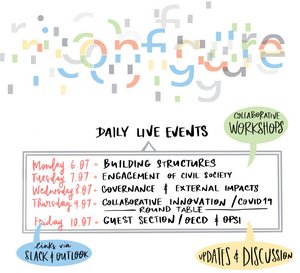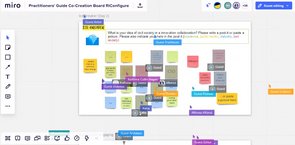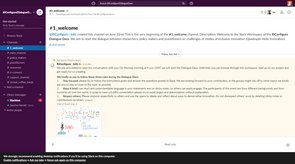Engagement Goes Virtual
Authors: Robert Braun, Anna Gerhardus, Sascha Harold, Shauna Stack and Johannes Starkbaum
Getting people engaged in a workshop is always a challenge. Doing it virtually can be even tougher. The following steps are designed to help create more inclusive online experiences – for yourself as well as your participants.
The magnitude of the Corona crisis took us all by surprise. Shops were closed down, wherever possible people had to work from home and events got cancelled or postponed. The scientific community was afflicted as well. One event affected, like many others, by the measures taken against the spread of the Coronavirus, was a Dialogue Event, that set out to take place at the Institute for Advanced Studies in May. As part of the EU project RiConfigure, the workshop aimed to foster collaboration among the public sector, industry, academia and civil society to address the challenges of our time. Faced with restrictions by the Austrian government and a partial lockdown announced in March, the organizational team had to decide: What to do?
Different options were on the table. Cancelling the event altogether was quickly discarded and the team decided to move the dialogue event from the physical to the virtual space. The workshop was reframed as weeklong virtual participatory event and postponed to the beginning of July to give enough time for planning. The main question was how to get people not only to show up (virtually), but to actively engage and interact with one another online. The following five steps were of particular relevance in achieving that goal.
How can an event be made accessible for as many people as possible?
1. Use different tools – but keep it simple!
One advantage of hosting a virtual event is a vast range of different tools and software that each have their specific purpose and field of application. Finding the right mix and creating the technical architecture of the event takes time and should be well thought out. For the Virtual Dialogue Days, the architecture looked like this: A slack platform was the central meeting place for all participants. Several thematic channels – and one for having a virtual coffee break –structured the space and gave it shape. Each day there was one live session held via Zoom, Mentimeter was used to make those sessions participatory. Furthermore, an Online Whiteboard, created with Miro, was used during the whole event to collect ideas and input of the participants. While all those tools and apps created a unique online environment that enabled and fostered participation, it was also important to not overwhelm attendees. Finding the fine line between creating an interesting and engaging experience while at the same time keeping it simple enough for both participants and the organizational team is key.
2. Create an inclusive environment
RiConfigure’s core idea is to bring together actors from the business/industry sector, the public sector, academia and civil society to imagine and deliver innovation for people and problems. Along with that goal comes the issue of inclusiveness. How can an event be made accessible for as many people as possible? For the Virtual Dialogue Days that question had several consequences. First, the event – originally planned as a one-day affair – was stretched to five days with a limited number of live events supplemented by resources that could be accessed 24/7. Furthermore, the workshop had participants mostly from Europe but also from South America. To accommodate that fact, timetables for live events were scheduled in a way that made it possible for both to participate during the day.
3. Preparation and testing are key
Murphy’s law is especially true if technology is involved. It is therefore essential to plan ahead of the event and train all the people involved. Everyone needs to know when to be where at what time. Especially important: Do a test run of the event with the whole organizational team involved. Online events need as much organizational staff as regular events – if not more so. That’s why it’s important that everyone’s roles are clearly defined and communicated before the event starts. Also, technical problems might be considered at all times. Both participants and organizers can face some sort of restraint in their possibility to access platforms or speak during the live sessions. The challenge was to establish structures that support all kinds of challenges and fast reaction if there was a problem.
4. Work towards a goal
Defining a goal that all participants work towards can help enhance engagement. Introduce that goal right at the start of the workshop and make sure to include participants along the way. At the Virtual Dialogue Days one of the pre-defined goals was co-creating a policy brief by picking up ideas and lessens at each day of the event. Besides being mentioned in the policy brief, participants had the opportunity to engage even more by contributing as a co-author.
5. Go with the flow
No matter how well planned your event might be, there is limited control over how participants might act and interact with your virtual structure. People might use tools in different ways than originally intended, therefore it is important to go with the flow, see how the event unfolds and adapt accordingly. If you push too much in one direction or ignore the challenges that arise, it might lead to participants just logging off the event, as leaving an online event is much easier than physically leaving offline events.
These elements made the Dialogue Days work better than could be expected at the time when the decision to go online was made. More than 80 people have been engaged in discussions about collaborative innovation across the five days and beyond. The process was inspired by the Austrian initiative Community Creates Mobility, which was a pioneer for transforming participatory events into the virtual world and supported by the graphic designer Chiara de Eccher, who helped us to translate and communicate our findings to a broader audience.



